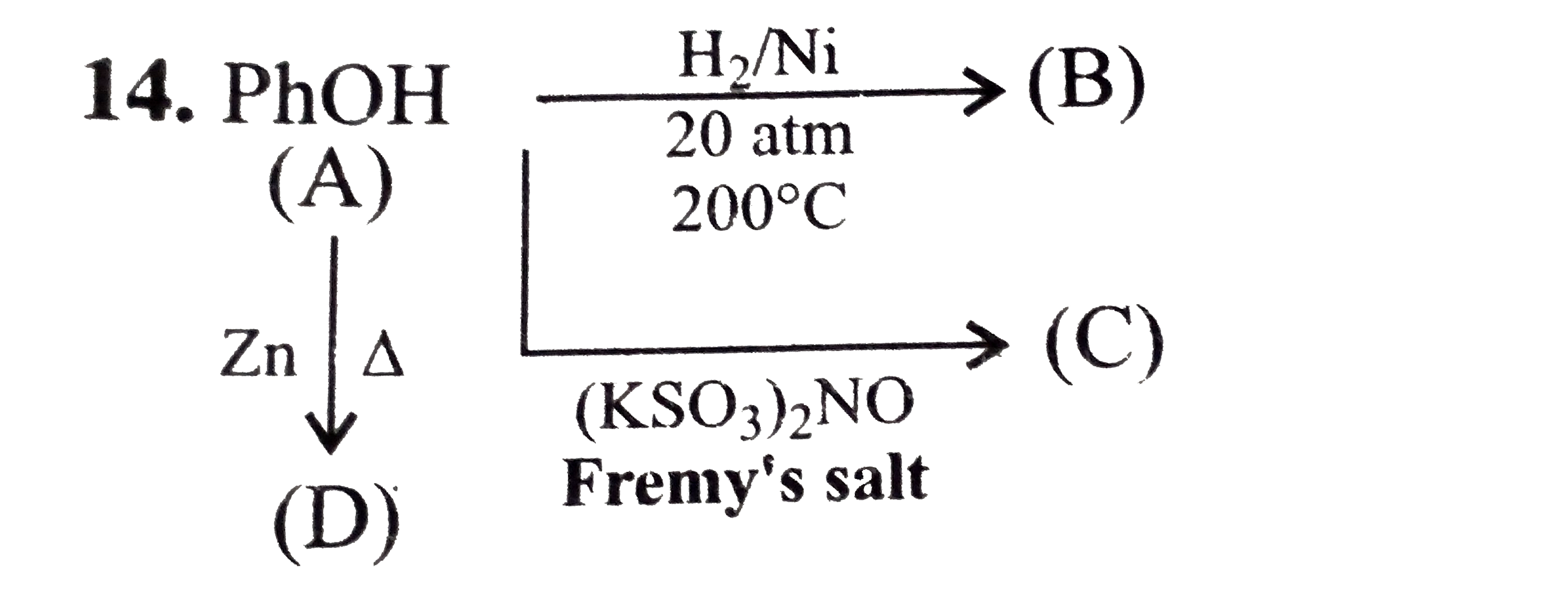A transition metal A has 'spin-only' magnetic moment value of 1.8 Bm. When it is reacted with dilute sulphuric acid in the presence of air, its compound B is formed. B reacts with compound C to give compound D with the liberation of iodine. Then the metal A and compounds B, C and D are respectively
The correct Answer is:C
To solve the problem step by step, we need to analyze the information given about the transition metal A and its reactions.
Step 1: Determine the identity of transition metal A
The magnetic moment (μ) is given as 1.8 B.M. The formula for calculating the spin-only magnetic moment is:
μ=√n(n+2)
where n is the number of unpaired electrons. Setting up the equation:
1.8=√n(n+2)
Squaring both sides gives:
3.24=n(n+2)
Rearranging this gives:
n2+2n−3.24=0
Using the quadratic formula n=−b±√b2−4ac2a:
n=−2±√22+4⋅3.242
n=−2±√4+12.962
n=−2±√16.962
n=−2±4.122
Calculating the two possible values for n:
1. n=2.122=1.06 (not valid, as n must be an integer)
2. n=−6.122=−3.06 (not valid)
Thus, n=1 is the only feasible solution, indicating that metal A has 1 unpaired electron. The transition metals with 1 unpaired electron include Copper (Cu).
Step 2: Identify compound B formed by the reaction of A with dilute sulfuric acid
When Copper (Cu) reacts with dilute sulfuric acid (H₂SO₄) in the presence of air, it forms Copper(II) sulfate (CuSO₄) and hydrogen gas (H₂). Therefore, compound B is:
Compound B: CuSO4
Step 3: Identify compound C
The problem states that compound B reacts with compound C to form compound D with the liberation of iodine. A common reaction involving CuSO₄ is its reaction with potassium iodide (KI). Thus, we can identify compound C as:
Compound C: KI
Step 4: Identify compound D formed from the reaction of B and C
When CuSO₄ reacts with KI, the reaction produces Copper(I) iodide (CuI) and potassium sulfate (K₂SO₄), along with the liberation of iodine (I₂):
CuSO4+2KI→Cu2I2+K2SO4+I2
Thus, compound D is:
Compound D: Cu2I2
Final Summary
- Metal A: Copper (Cu)
- Compound B: Copper(II) sulfate (CuSO₄)
- Compound C: Potassium iodide (KI)
- Compound D: Copper(I) iodide (CuI)
The magnetic moment (μ) is given as 1.8 B.M. The formula for calculating the spin-only magnetic moment is:
n=−2±√4+12.962
n=−2±√16.962
n=−2±4.122
2. n=−6.122=−3.06 (not valid)
When Copper (Cu) reacts with dilute sulfuric acid (H₂SO₄) in the presence of air, it forms Copper(II) sulfate (CuSO₄) and hydrogen gas (H₂). Therefore, compound B is:
The problem states that compound B reacts with compound C to form compound D with the liberation of iodine. A common reaction involving CuSO₄ is its reaction with potassium iodide (KI). Thus, we can identify compound C as:
When CuSO₄ reacts with KI, the reaction produces Copper(I) iodide (CuI) and potassium sulfate (K₂SO₄), along with the liberation of iodine (I₂):
- Metal A: Copper (Cu)
- Compound B: Copper(II) sulfate (CuSO₄)
- Compound C: Potassium iodide (KI)
- Compound D: Copper(I) iodide (CuI)
Topper's Solved these Questions
- D & P-BLOCK ELEMENTSBook:ERRORLESS Chapter:D & P-BLOCK ELEMENTSExercise:Critical Thinking
Explore 21 Videos
- D & P-BLOCK ELEMENTSBook:ERRORLESS Chapter:D & P-BLOCK ELEMENTSExercise:JEE Section (Only one choice correct answer)
Explore 38 Videos
- D & P-BLOCK ELEMENTSBook:ERRORLESS Chapter:D & P-BLOCK ELEMENTSExercise:JEE Section (Numeric answer type questions)
Explore 2 Videos
- COORDINATION CHEMISTRYBook:ERRORLESS Chapter:COORDINATION CHEMISTRYExercise:JEE(ADVANCED 2018 MORE THAN ONE CHOICE CORRECT ANSWER
Explore 1 Video
- ELECTROCHEMISTRYBook:ERRORLESS Chapter:ELECTROCHEMISTRYExercise:Jee Section JEE (Advanced) 2018 (Numberic answer Type Questions)
Explore 2 Videos
Similar Questions
Knowledge Check

The compounds (B), (C ), (D), respectively are:ACyclohexanol, benzene, and p-quinoneBBenezene, cyclohexanol, and p-quinopneCp-Quinoue, cyclohexanol, and benezeneDCyclohexanol, p-quinone, and benzeneAn organic compound A reacts with PCl5 to give compound B. Compound B reacts with Na/ether to give n-butane. What are compounds A and B ?
AC2H5OH and C2H5ClBC2H5Cl and C2H5ONaCC3H7OH and C3H7ClDC4H9OH and C4H9ClA compound of vanadium chloride has spin only magnetic moment of 1.73 BM. Its formula is
AVCl2BVCl5CVCl4DVCl3
An organic compound A reacts with PCl5 to give compound B. Compound B reacts with Na/ether to give n-butane. What are compounds A and B ?
View SolutionA compound of metal ion Mx+(z=25) has spin only magnetic moment of √15B.M. The positive O.S. of the metal is
View SolutionA compound (A) of boron reacts with Nme3 to give an adduct (B) which on hydrolysis gives a compound (C) and hydrogen gas. Compound (C) is an acid. Identify the compounds A,B and C. give the reactions inovolved.
View SolutionThe 'spin only' magnetic moment of Ti in a given compound is 1.73 BM. The oxidation state and configuration of Ti in the compound are --------- respectively.
View SolutionAn organic compound [A] reacts with sodium metal to from [B]. On heating with conc. H2SO4, [A] gives diethyl ether. Compound [A] and[B] are respectively.
View Solution
